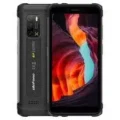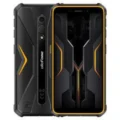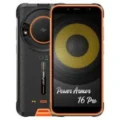Ulefone Armor 21
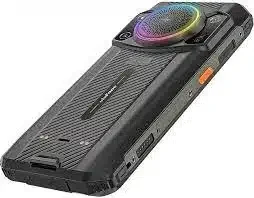

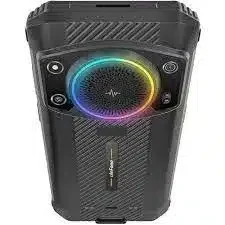
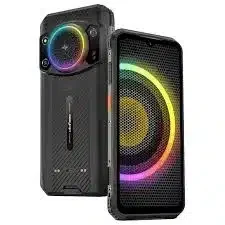

- : 8GB RAM Helio G99
- : 6.58" 1080x2408 pixels
- : 9600mAh 33W
- : 64MP 2160p
Ulefone Armor 21: Unbreakable Strength Meets Powerful Performance
The Ulefone Armor 21 isn’t your average smartphone. It’s built for those who demand toughness without sacrificing performance, making it the perfect companion for demanding adventures.
Unbreakable Build:
- Fearless Design: Engineered to conquer any environment, the Armor 21 boasts IP68 certification, making it dustproof and waterproof for up to 30 minutes at 1.5 meters. Accidental drops from up to 1.2 meters are no problem for its shockproof construction.
Immersive Entertainment:
- Large, Vivid Display: Dive into a world of vibrant visuals with the expansive 6.58-inch Full HD+ display featuring a sharp 1080 x 2408 pixel resolution. Whether you’re gaming, watching movies, or browsing the web, the Armor 21 delivers an immersive experience.
Powerhouse Performance:
- Smooth Operation: The MediaTek Helio G99 processor, coupled with 8GB of RAM, provides seamless performance for everyday tasks, multitasking, and even casual gaming.
Capture Every Moment:
- Triple Camera System: The versatile camera system boasts a 64MP main sensor for capturing stunning daytime photos. A dedicated 24MP night vision sensor ensures clear pictures even in low-light conditions. On the front, a 16MP camera lets you take sharp selfies and flawless video calls.
Untiring Power:
- Long-lasting Battery: The massive 9600mAh battery offers extended usage throughout the day. When it’s time to recharge, 33W fast charging technology quickly gets you back on track.
Modern Software Experience:
- Android 13: The Armor 21 runs the latest Android 13 operating system, providing access to the newest features and security updates.
The Ulefone Armor 21 is the ideal choice for those who lead active lives and need a reliable device. It’s the perfect blend of unwavering toughness, long-lasting battery, and powerful performance for all your adventures.
Want to Learn More?
Furthermore Visit the official website of Ulifone for detailed information about the Ulefone Armor 21: Ulifone Official Website
Still Unsure?
If you’re still unsure about your choice, explore other options from Ulifone at your nearest store: Ulifone Store
Specs
Network
| 2G Network GSM 850 / 900 / 1800 / 1900 - SIM 1 & SIM 2 (dual-SIM) CDMA 800 / 1900 |
GSM 850 / 900 / 1800 / 1900 - SIM 1 & SIM 2 |
| 3G Network | HSDPA 850 / 900 / 1700(AWS) / 1900 / 2100 |
| 4G Network | 1, 2, 3, 4, 5, 7, 8, 12, 17, 19, 20, 28, 34, 38, 39, 40, 41, 66 |
| Speed | HSPA, LTE |
LAUNCH
| Announced | May, 2025 |
| Status | Available. Released 2023, May 30 |
BODY
| Dimensions | 176 x 81.6 x 18.1 mm (6.93 x 3.21 x 0.71 in) |
| Weight | 400 g (14.11 oz) |
| SIMs SIM (Subscriber Identity Module) is a small card that contains mobile network subscriber's account information. This allows the phone using the card to attach to a mobile network. The SIM card is most commonly associated with GSM and UMTS mobile networks. Moving a SIM card from one phone to another allows a subscriber to switch mobile phones without having to contact their mobile network carrier. SIM cards can also be used by a phone to store limited amounts of data, such as phone numbers and text messages. |
Dual SIM (Nano-SIM, dual stand-by) IP68/IP69K dust/water resistant (up to 1.5m for 30 min) Drop-to-concrete resistance from up to 1.5m MIL-STD-810H compliant Accessory connector (ulefone endoscope, microscope) |
Display
| Display Type Display Technology => A number of display technologies and types used in mobile phones => TFT (Thin Film Transistor), IPS (In-Place Switching), OLED (Organic Light Emitting Diode), AMOLED (Active-Matrix Organic Light-Emitting Diode), Super AMOLED (an even advanced version of AMOLED), Resistive Touchscreen (Resistive touchscreens contain two layer of conductive material with a very small gap between them which acts as a resistance), Capacitive Touchsceen (Capacitive touchscreen technology consists of a layer of glass coated with a transparent conductor) | IPS LCD, 120Hz |
| Size | 6.58 inches, 104.3 cm2 (~72.6% screen-to-body ratio) |
| Resolution | 1080 x 2408 pixels, 20:9 ratio (~401 ppi density) |
PLATFORM
| Operating System OS => Every computer system run on a base software called Operating System (OS). Operating System controls all basic operations of the computer (such as smartphone, PDAs, tablet computers and other handheld devices). The Operating System allows the user to install and run third party applications (apps), apps are used to add new functionality to the device. | Android 13 Chipset Mediatek Helio G99 (6nm) |
| CPU CPU (Central Processing Unit) mostly known as processors, CPU processes instructions in order to carry out certain functions that make your device operate properly. Processors are often described as the brain of computers, smartphones and tablets, Smartphones and tablets rely on processors to carry out their every task, Processors are an incredibly important factor in selecting any type of computing device, including your smartphone. | Octa-core (2x2.2 GHz Cortex-A76 & 6x2.0 GHz Cortex-A55) |
| GPU GPU (Graphics Processing Unit) is a single-chip processor designed to rapidly manipulate and alter memory to accelerate the creation of images in a frame buffer intended for output to a display, This includes things such as lighting effects, object transformations, and 3D motion. | Mali-G57 MC2 |
MEMORY
| Card Slot Memory Card Slot is a special slot for inserting a memory card. Memory cards allow you to expand the phone's built-in memory, A memory card (sometimes called a flash memory card or a storage card) is a small storage medium used to store data such as text, pictures, audio, and video, for use on small, portable or remote computing devices such as mobile phones, mp3 players, digital cameras. | microSDXC (dedicated slot) |
| Internal | 256GB 8GB RAM |
MAIN CAMERA
| Cameras Specs Today’s smartphones come equipped with a very comprehensive set of camera related specifications. Our smartphone, for many of us, has become our primary camera due to it being the one we always have with us. |
64 MP, f/1.9, (wide), 0.8µm, PDAF 24 MP, f/1.8, (night vision), 2 infrared night vision lights |
| Video | 4K@30fps, 1080p@30fps |
| Camera Features | LED flash, HDR, panorama |
SELFIE CAMERA
| Cameras Specs Today’s smartphones come equipped with a very comprehensive set of camera related specifications. Our smartphone, for many of us, has become our primary camera due to it being the one we always have with us. |
16 MP, f/2.2, (wide), 1.0µm |
| Video | 1080p@30fps |
SOUND
| Loudspeaker | Yes (122dB) |
| 3.5mm jack | Yes |
COMMS
| WLAN |
Wi-Fi 802.11 a/b/g/n/ac, dual-band |
| Positioning | GPS, GLONASS, GALILEO, BDS |
| Bluetooth Bluetooth is a wireless communications technology for exchanging data between mobile phones, headsets, computers and other network devices over short distances without wires, Bluetooth technology was primarily designed to support simple wireless networking of personal consumer devices. | 5.2, A2DP, LE |
| Infrared Infrared connectivity is an old wireless technology used to connect two electronic devices. It uses a beam of infrared light to transmit information and so requires direct line of sight and operates only at close range. | |
| USB | USB Type-C 2.0 |
| NFC NFC (Near field communication) is a set of standards for smartphones and similar devices to establish peer-to-peer radio communications with each other by touching them together or bringing them into proximity, usually no more than a few inches. | |
| Radio |
Features
| Sensors Sensors are electronic components that detects and responds to some type of input from the physical environment. The specific input could be light, heat, motion, moisture, pressure and location, The output is generally a signal that is converted to use in computing systems, a location sensor, such as a GPS receiver is able to detect current location of your electronic device. |
Fingerprint (side-mounted), accelerometer, proximity, compass, gyro, barometer |
BATTERY
| Battery Type Battery Type => Cell phones run on various kinds of batteries depending on the manufacturer, phone size or shape and features. There are basically four types of cell phone batteries => Lithium Polymer, Lithium Ion, Nickel Metal Hydride and Nickel Cadmium. | Li-Ion (Lithium Ion) |
| Charging The functionality responsible for recharging batteries in portable devices, such as mobile phones, significantly influences both battery lifespan and the practicality of daily product usage.The charging process, encompassing factors like voltage, current, and completion actions, is contingent upon the battery's size and type.Contemporary battery chargers dynamically adjust charging parameters based on the battery's current charging state. Charging an empty battery poses no safety risk, allowing for a quicker charging process. Consequently, many charging speed benchmarks, including ours, specify the battery level achieved after a 30-minute session on an empty battery.Standard chargers with a power output of 5V/1A, equivalent to 5W, serve as a baseline, with anything surpassing this speed classified as quick or fast charging. | 33W wired |
MISC
| Colors |
Black |
| Price | About 280 EUR |
TESTS
Reviews
Disclaimer Note
We strive to maintain accurate and up-to-date content on our website for general information purposes only. Please refrain from using the material for business, legal, or any other decisions.


